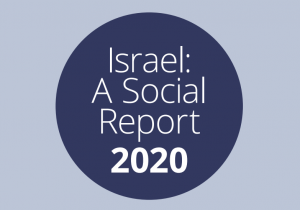Israel’s Heart is in Western Europe, Her Feet are in the Eastern and Southern Fringes
- Israelis like to think of their country as part of Western Europe. However, on most socio-economic indicators, Israel is more similar to the eastern and southern fringes of the European continent. The median disposable income of Israeli households, the per capita GDP and the average wage resemble those of Slovenia, Spain, Greece and the Czech Republic. The poverty rate in Israel also distances it from Western Europe, being similar to the rates in Mexico and Chile.
- During the last decade (2004-2013) the Israeli economy showed higher growth rates than the countries of Western Europe. However, economic growth alone will not bring Israel closer to the European model. Firstly, if Israel is to attain the same standard of living, it needs to grow at a much faster pace. Secondly, it needs to distribute the fruits of economic growth more evenly.
Israel is not realizing its potential for economic growth, among others due to the absence of a political settlement with the Palestinians. The two intifadahs were very damaging to the Israeli economy, but more limited confrontations have become more frequent: the campaigns Days of Penitence (2004), Rainbow (2004), First Rain (2005) Summer Rains (2006), Hot Winter (2008) Cast Lead (2009-2009), Pillar of Defense (2012) and Protective Edge (2014). The direct economic implications of each of these confrontations was limited – the Bank of Israel estimates that the Protective Edge campaign reduced GDP by no more than 0.3% — but the accumulated effect of all the confrontations results in long-term harm to the social groups and geographic areas directly affected and creates an atmosphere of macro-economic instability.
Another obstacle in the way of raising the standard of living for all Israelis is that during the last decade at least, instead of trickling down, as the political leadership claims they do, the fruits of economic growth trickle up, defying nature. The share of employers in the national income grew over the last decade from 11% to 15%, at the expense of employees, whose share decreased from 66% to 62%. The only salaries that increased significantly were those of senior managers: the cost of their salaries doubled between 2000 and 2010. In 2013, the cost of the salaries of the general managers of the 100 largest corporations on the Tel Aviv Stock Market was on average NIS 6.158 million per year, or NIS 513,000 per month.
- Wealth, too, increased: between 2003 and 2013, the financial assets held by the public grew by about 80%, from NIS 1,704 billion to NIS 3,048 billion (in 2013 prices). In the absence of breakdowns by different social strata, one can only estimate on the basis of what is known in other countries that most of the gains are in the hands of the top decile and top percentile.
- In contrast, many Israelis receive salaries described as low by OECD standards: up to two-thirds of the median wage. In 2012, 22.1% of Israelis were at this wage level, placing Israel nearly at the bottom of the OECD ladder: third last.
- Women’s average monthly salary was 62.2% of men’s average monthly salary in 2003; in 2013 it was somewhat higher: 68.1%. In contrast, the gender gap in hourly pay remained stable at 15.5%.
- The average wage of Ashkenazi salaried workers decreased in 2013, from 42% above the overall average wage to 32%. The average wage of Mizrahi salaried workers remained the same at 11% above the overall average wage. The average wage of Arab salaried workers was much lower: since 2008 it has remained at between 67% and 68% of the overall average wage.
- The national unemployment rate is low: less than 6%. However, this rate reflects mainly the Jewish localities in the center of the country. When one leaves the center, the percentage of job seekers increases considerably, mainly in Arab localities and in some of the Jewish development towns: Rahat (33.3%), Umm el-Fahem (30.8%), Arrabe (27.8%) Sakhnin (24.8%), Tamra (23.9%), Maghar (23.9%), Yeruham (16.4%), and Dimona (15.4%).
- The government of Israel does not strive to balance the uneven results of economic growth. Government expenditure (including the expenditures of local authorities), which in 2013 amounted to 41.3% of GDP, placed Israel at one with the countries of Eastern Europe as well as those with a tradition of low government spending, like New Zealand and Canada (whose defense expenditures are much lower than Israel’s). Moreover, government social security and social assistance expenditures stood at no more than 15.8% of GDP, close to the very bottom of the ladder of such expenditures in OECD countries.
- In a recent public debate over whether or not Israel should strive to increase the number of youngsters enrolled in vocational high schools, Development Minister Silvan Shalom challenged Prime Minister Binyamin Netanyahu “Why don’t you send your own son [to a vocational high school] to become a welder.” He was referring to a situation that has been around for a long time – one in which vocational high schools are typically found in low-income communities. An examination of the location of the vocational schools of the two largest networks in Israel, Ort and Amal, revealed that out of 159 such schools, 113 (71%) were located in communities with low socio-economic status: 35 in Arab localities, 43 in Jewish development towns and 35 in localities at the bottom half of the socio-economic ladder. In most affluent localities, if there are vocational high schools, they are located in the poor neighborhoods.
- Government spending on health is low by OECD standards. As a result of inadequate health budgets, Israeli households are spending more and more on private medical insurance that allows those who can pay more to receive treatment first. Doctors who once spent the whole day serving the public health system now disappear in the afternoons to serve the private system that is growing alongside the public one.





